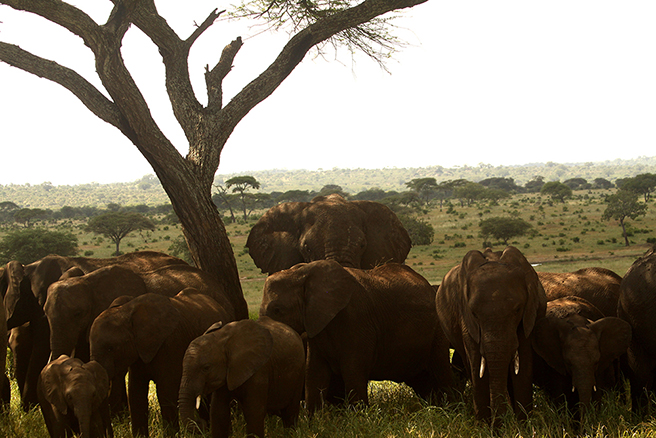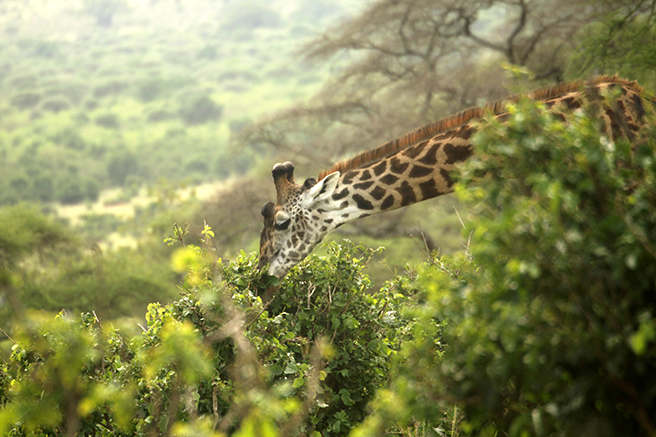Leslie Encounters Cute Baby Animals (and more!) on Safari

Full days in the parks followed one of two patterns: separate morning and late afternoon drives (the norm) or an all-day drive with a picnic lunch in the park. As you’ll see later, though, some of those picnics were pretty impressive. Our first full day in Tarangire, aka Day 2, was a two-drive day, and our second (Day 3) was an all-day adventure. The pictures you’ll see with this post will be a small (very small!) selection of the many shots from those two days.
At the risk of sounding like a complete bore – and only two days into the trip! – Day 2 was a day of amazing wildlife viewing and countless photo opportunities. I’m not kidding when I say I think I went home with at least 5,000 photos between my three cameras. Here’s my theory, though, if you’ll allow me to digress for a moment: If I miss a shot, I can’t go out the next weekend and try again. And when you’re photographing animals, the flick of an ear or the literal blink of an eye can make the difference between an OK shot and a good one. (Or, if you’ve got the kind of skills I lack, between a good shot and a great one.) So even when the animals are seemingly sitting around doing nothing, I snap a ton of pictures, then ditch most of them when I get home. And when they’re moving I take even more, in the (often vain) hope of getting one that’s not too blurry.
The morning of Day 2 was most notable for all the elephants we saw, everything from babies to one big bull. One herd crossed the road right in front of us – needless to say, we stopped and gave them the right of way – and another herd split when they saw us, with half crossing in front and half behind. The Rovers we rode in were big – I admit I’m short, but I had to grab hold of something and pull myself up and in, and when I stood and looked out the pop-top, I’d guess my line of sight was a good 8’ up from the ground – but the elephants made them look small. The good thing is that, to the wildlife, vehicles are like big rocks or trees, just there, not particularly interesting and mostly just something to be detoured around. Still, it’s hard not to feel awed in the truest sense of the word when an animal that’s 8’ or higher at the shoulder walks by, much less when an entire herd marches past.
One of the (many) wonderful things about this trip was the variety of behaviors we saw on top of the variety – and sheer number – of animals, and the elephants were particularly generous in that regard. We saw babies tucked under their mamas’ bellies and stealing grass from the grownups, we saw elephants enjoying the water and giving themselves dirt baths, moving in herds and alone, rubbing against trees and giving us the proverbial hairy eyeball.
It wasn’t all elephants, though. Once again we saw a multitude of birds, including my favorite, the lilac-breasted roller, as well as the black-bellied bustard (one of three Tanzanian varieties of bustard, all of which we saw before the end of our trip), the southern ground hornbill, the classic white storks that nest in European chimneys and migrate to Africa for the winter, and oxpeckers feeding on giraffes. Or rather, oxpeckers perching on giraffes and eating the ticks that have hooked on to the giraffes.

And of course that means we saw giraffes –Masai giraffes, to be specific, the only type we saw during our trip – so marvelously ungainly and graceful at the same time. When they walk they pace, with both legs on one side of the body moving together, but when they run they alternate legs in a more classic mammalian gait. And if you ever want to stump your friends at a party, ask them how many vertebrae giraffes have in their necks. The answer is seven, the same as humans and all but three other mammals (manatees and a couple of others); it’s just that giraffe vertebrae are very, very big, which explains why they can stretch their necks into the treetops to feed but can’t coil them around like snakes. More giraffe fun facts: Their tongues are blue and 18” long, and they use them to strip leaves off trees, especially acacias. Somehow they manage not to be bothered by the thorns. Mothers give birth standing up, so baby giraffes have a 6’ drop to the ground – and are 6’ tall themselves. Oh, and if you ask the guides when the giraffes like to do anything: mate, give birth, whatever – the answer is always some version of “whenever.” Apparently, unlike most species, giraffes don’t have specific seasons for anything. They just suit themselves. Bet you didn’t know this blog was going to turn into a wildlife textbook, did you? *g*
We also saw rock hyrax (an animal Amy had been hoping to spot), impala, gazelle, turtles Burchell’s (aka plains) zebra and vervet monkeys. Some of them would have been impossible to miss, but throughout the whole trip it was the amazing eyesight and knowledge of our three guides – Hashim, our head guide, and Mustapha and Harrison – that ensured that we didn’t miss anything. All the park roads were dirt, and most of them were rutted and often muddy, making them a real challenge to negotiate. Somehow, though, our guides managed to keep the Rovers moving safely forward and still spot animals hundreds of yards away, hidden in the grass by the side of the road and anywhere in between.
After lunch and a rest back at our nyumba – a very comfortable way to spend the hottest part of the day, when the animals also tend to rest and the light is too strong and direct for good photo opportunities – we would pile back in the Rovers around 3:00 or 3:30 and head back out to explore. That afternoon wasn’t as wildlife heavy as the morning had been, but it was still a lot of fun. We drove to Lake Burungi, a salt lake at the edge of the park, which means it doesn’t draw wildlife the way the freshwater lakes do. It was very austere looking, at least to me, and the area around it seemed more barren, I’m sure because most plants can’t survive without fresh water any more than most animals can. Still, we saw a lot of birds – including yellow-collared lovebirds and a tawny eagle.
And the animals we did see were definitely interesting. We not only saw warthogs, we saw baby warthogs, and as crazy as this may sound, they were some of the cutest babies we saw the whole trip. We also saw a dik-dik, the smallest of all the antelopes we encountered, and a very handsome waterbuck who stood and posed, then took off running. After such an elephant-filled morning, we only saw one lone elephant that afternoon, but it was a very impressive male.
Then it was back through the gauntlet of tsetse flies – less than 1% of the tsetses in Tanzania carry sleeping sickness, so they’re a literal pain but not a health issue – to the nyumba, making sure to arrive by sundown. I hadn’t realized it ‘til we got there, but there are no night drives allowed in the parks. It wouldn’t be safe for the people or – most of all – the animals, which are habituated to cars and roads, so they would be at real risk in the dark, when the many vehicles would have only limited visibility. On top of that, the headlights would be both disorienting and potentially damaging to the animals’ eyesight. As neat as it would have been to see nighttime behavior, I have no problem with putting the animals’ welfare first.